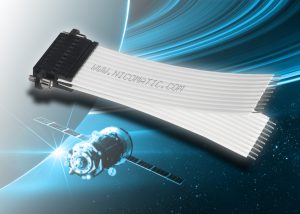Leading manufacturer of high-performance interconnect systems, Nicomatic is showcasing its high-reliability, space-proven modular interconnects – including its new FFCs for space: dense, lightweight flexible cables that ensure signal and power connection in all types of space applications – on stand D37 at Space-Comm Expo 2024, taking place from March 6 to 7, at Farnborough International Exhibition & Conference Centre in Farnborough, UK.
A growing space powerhouse, with industry turnover of £17.5 billion in 2022, the UK contributes 6.5% to the global space market. The UK’s largest space industry event, Space-Comm Expo gathers space, aerospace & defence, and downstream & upstream industries for two days of high-level networking, exhibition, education and business, focused on the commercial future of space. Supported by key industry associations, Space-Comm Expo showcases developments in technology and the end-to-end supply chain for products, services and applications servicing commercial enterprises, Government and defence organisations.
Harsh-environment electronic space systems demand highly specialised interconnect components to ensure peak technical performance and secure data transmission in the extreme conditions of space – including vacuum, radiation and dramatic temperature fluctuations. Nicomatic’s DMM, CMM and EMM Series connectors have all been specified in recent space applications, including the European Space Agency’s (ESA) ExoMars astrobiology programme to search for signs of past life on Mars (CMM connector in the ExoMars Orbiter), China’s space programme for exploration on the Moon (custom connector in the Jade Rabbit rover), the ESA-led JUICE space mission (CMM connector in JUICE’s mass spectrometer for the observation of Jupiter’s icy moons), and multiple other international space and satellite programmes.
Dense, lightweight and designed to be folded or coiled, the new FFCs (flat flexible cables) for space not only deliver significant weight and space savings, but also overcome space industry challenges by integrating cables into complete interconnect solutions. Manufactured from NASA-grade materials to meet outgassing requirements, FFCs for space create strong board-to-board connections on PCBs and display boards in electronic equipment, systems and sub-assemblies, linking data and power points in tight areas. These lighter, more flexible interconnects ensure robust, reliable signal and power connection for electrical harnessing systems in satellites, exploration rovers, solar arrays, research orbiters, HD cameras, radar and satcomm systems, communication units, optical sensors and simulators.
DMM Series 2mm pitch low-profile metal connectors comply with MIL-DTL-83513G and enable a far wider choice of arrangements compared to other mil-spec connectors, such as Micro-D or Sub-D. Highly modular, contacts can be signal (LF), power (HP) or coax (HF), with up to 10 million arrangements for board-to-board, board-to-wire, wire-to-wire or panel mount.
CMM Series 2mm pitch MIL-DTL-55302F connectors also offer signal, power and coax, with more than 20 million arrangements possible. They save up to 60% space and up to 50% weight compared with other connectors offering the same functionality. Shock-and-vibration-resistant, oxygen-free, radiation-resistant and able to withstand temperature cycling between -60°C and +260°C, CMM connectors are proven to withstand the rigours of space applications.
On a 1.27mm pitch, the MIL-DTL-83513 conformant EMM Series is more than 40% smaller than its parent CMM, or 20% compared to Micro-D. Key features include reversed contacts, integrated 90-degree back protection and interchangeable hardware. Again, extreme modularity is offered, with 4 to 60 signal contacts for board-to-board (thanks to secure wiping length) or board-to-wire configurations.
Highly experienced in solving the complex interconnect problems found in space projects, including creating custom solutions, Nicomatic engineers are available on stand D37 at Space-Comm Expo and throughout Nicomatic’s global network of offices.
 Instrumentation Monthly Test | Measurement | Control
Instrumentation Monthly Test | Measurement | Control
 The MCF3 fuse series:
The MCF3 fuse series:





 Safe to use and contamination-proof
Safe to use and contamination-proof
